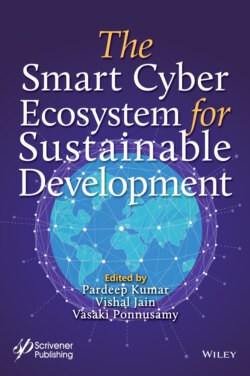Читать книгу The Smart Cyber Ecosystem for Sustainable Development - Группа авторов - Страница 52
2.6 Cognitive Radio Networks
ОглавлениеThe Federal Communications Commission (FCC) defines cognitive radio as: “a radio that can change its transmitter parameters based on interaction with the environment in which it operates”.
The main features of cognitive radio are as follows [14]:
Awareness: CR is aware of its surrounding environment through the sensing capability.
Intelligence: CR is a programmable intelligent wireless communication system capable of learning from information collected from the environment.
Adaptivity: CR adapts to the variation of the radio spectrum conditions and application requirements by dynamically reconfiguring its operational parameters.
Dynamic Spectrum Access has been proposed for efficient utilization of radio spectrum. Spectrum bands are categorized as licensed and unlicensed bands. Licensed bands are used by licensed users, called Primary Users (PUs). They have the priority to use the spectrum. Unlicensed users, called Secondary Users (SUs) can use the licensed bands as long as the PUs are not temporally using it; or as long as the PUs’ can properly be protected. However, SUs should vacate the licensed bands immediately when a PU is detected to be active. This will significantly improve spectrum utilization. SUs detect the conceivable vacant bands, determine operational channel, and eventually adjust their parameters. Thus, efficient spectrum sensing techniques are key to the successful operation of CR networks.
In CR systems, SUs should be able to [14]:
Sense the spectrum bands and determine the possible channels as well as activity of PUs.
Decide on the quality of available channels that satisfy users’ requirements.
Share the available channels with other SUs.
Avoid harmful interference to PU who is starting to use the any channel by vacating the channels PU just start operating on.
The detection of PU’s presence is a major challenge in CR. This process needs complex sensing technologies. This complexity stems from the nature of the electromagnetic signals, the multipath fading, and the changing interference. Spectrum sensing for CR systems is a very interesting research area. Researchers try to develop quick and accurate methods to detect the PU’s activity.
The transmission cycle of a SU can be represented as seen in Figure 2.8. The sensing process is performed periodically using one of the sensing methods. During the sensing time, the SU does not transmit data. After sensing, SU can decide to transmit on the same channel or switch to another channel, depending on PU presence. The transmission continues until the next sensing period. Clearly, the sensing time should be as short as possible, but at the same time enough for accurate sensing. Therefore, there is a trade-off between protecting the PU’s QoS and improving the QoS of SUs.
Figure 2.8 The transmission cycle of SU.
